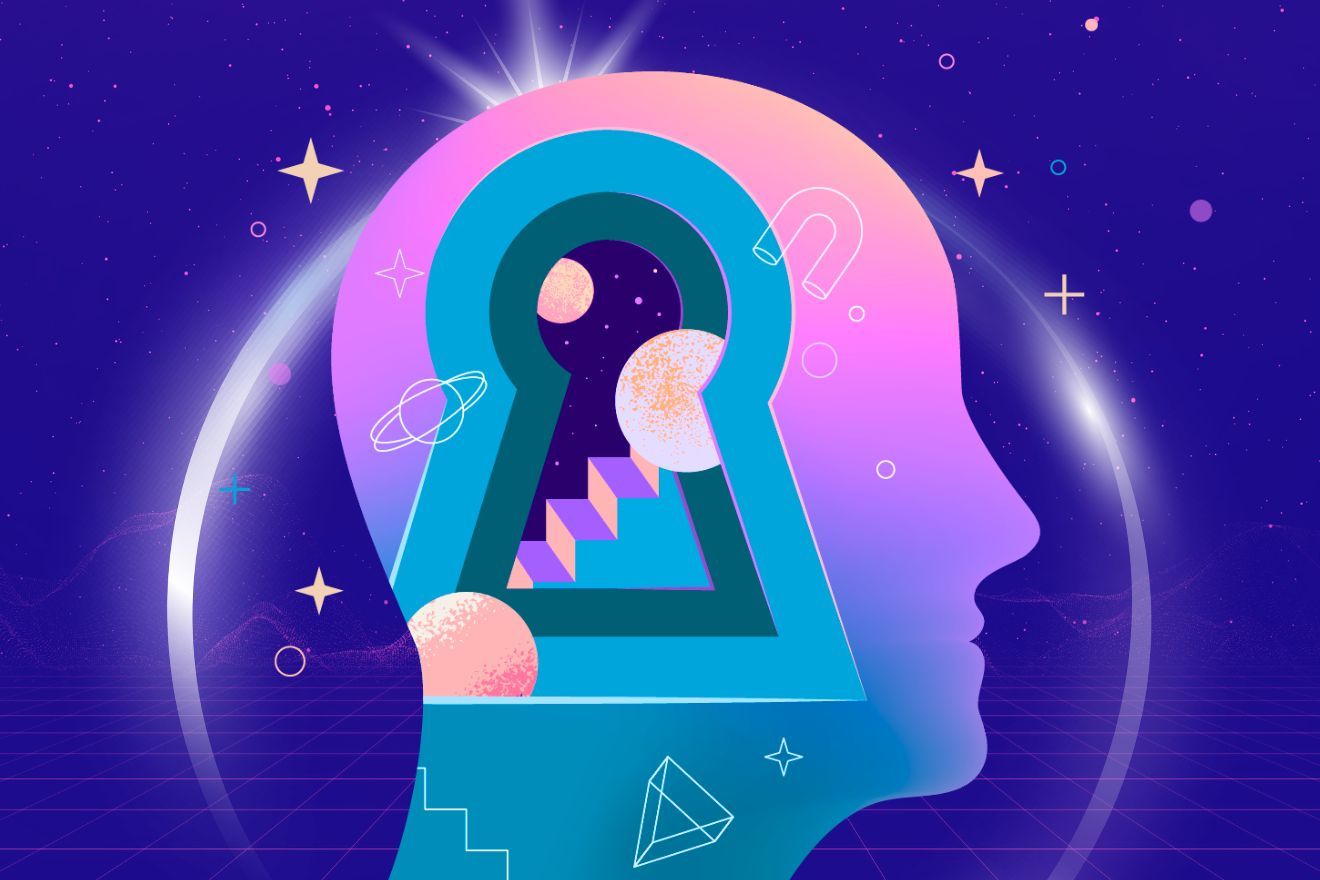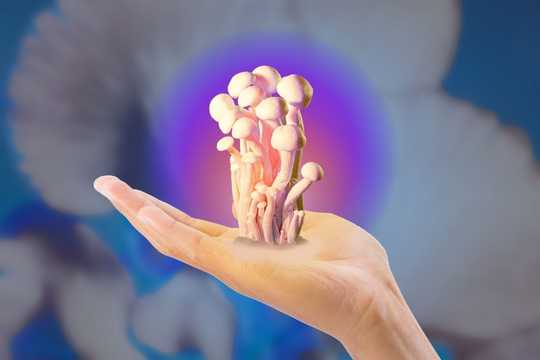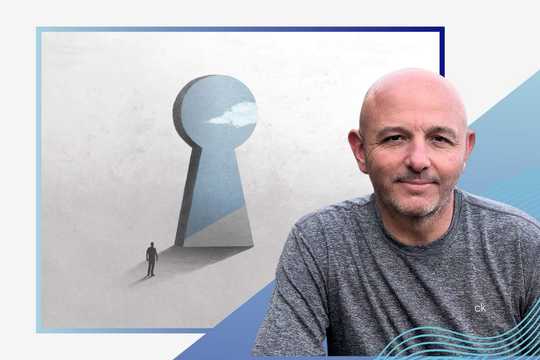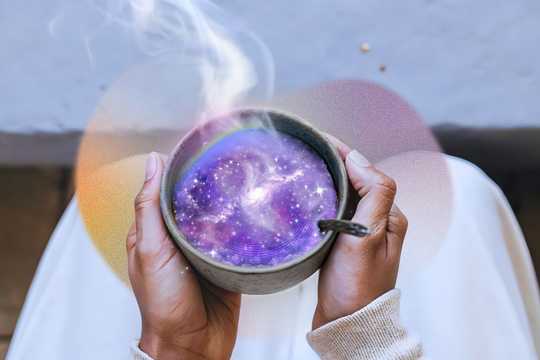In mainstream media, there’s a noticeable effort to disentangle spirituality and psychedelics, separating them from their spiritual connections. This oversight erases a profound dimension of psychedelic experiences because spirituality and psychedelics feel intrinsically linked. They can create a personalized guide to one’s particular recovery. This customized guidance is what occurred in my experience.
“Psychedelics facilitate profound spiritual connections. They could provide solace to those searching for self-compassion or estranged from organized religion.”
— Natalie Goldberg
Navigating traditional mental health treatments felt like treading a familiar yet dim path. Intrigued by the unknown, I ventured into the world of spirituality and psychedelics despite efforts to secularize the substances.
Confronting skepticism about altered consciousness, I sought more profound personal psychedelic trials. Ultimately, embracing spirituality and psychedelics together unveiled alternative therapeutic possibilities.
This merging can enable a bridge of conceptual boundaries. Spirituality, which transcends cultural differences, expands conventional healing modalities. Integrating these alternate-conscious planes offers personalized guidance, challenging my former binary beliefs on mental health.
This exploration suggests that the psychological flexibility of spirituality can provide transformative insights. Psychedelic therapy serves as a catalyst that propels into uncharted territories, where the fusion of mind, spirit, and therapy heralds a new era of understanding and healing.
Enlightenment From Psychedelics and Spiritual Skepticism
Conventional Treatments and Psychedelic Exploration
I momentarily set aside my nursing vocation to confront my depression head-on. Seeking healing, I turned to psilocybin after years of taking conventional antidepressants. At the start, I was unaware that psilocybin would uncover deep-seated trauma from a lifetime.
As I matured, my interest in psilocybin deepened. Despite my initial reluctance, I grew fascinated by the nexus of mental health, spirituality and psychedelics. Immersed in stories from neurologists like Oliver Sacks, I enjoy exploring the human mind’s intricacies. Facing new challenges, I used journaling to navigate my complex thoughts.
This curiosity led me to Richard Alpert, also known as Ram Dass. Once a Harvard professor, he became a psychedelic pioneer in the 1960s after being fired for providing psychedelics to his students. His insights into the complexities of psychedelics, presented through meaningful metaphors, captivated me.
Ram Dass combined psychology with profound inner exploration insights, indicating that true healing is internal. He often discussed how deep meditation unveils existence’s profound truths.
From his teachings, I grasped that only the present moment is tangible. Our views of the past and future are fantastical constructs. He taught that fear or shame heavily influences our mental framework. He stressed the importance of living in the moment and avoiding worries.
Be Here Now
Embarking on my psilocybin journey with Be Here Now, I found a pivotal moment in his recount of enlightenment. Insights into fear, as a fundamental emotion, illuminated a novel path to my personal understanding of therapy.
These insights suggested new ways to address underlying psychological challenges. Ram Dass’ narrative revealed a transformative healing process. It guided me to confront the deep-seated fears shaping my external behaviors or decisions.
His own transformation in India tells of his profound evolutionary journey. There, he moved from Harvard’s LSD experiments to embracing meditation for higher consciousness.
This shift was not just about psychedelic exploration. It was about deep, meditative introspection that allowed Ram Dass to overcome his fears. I thought his story stressed the importance of integrating spiritual insights into daily life, enhancing well-being on a psychological level, I thought. This meditative approach, beyond just psychedelic use, spoke to me.
Although not every meditative experience was logically interpretable, he highlighted its value in promoting inner healing and urged the examination of metaphors presented by these visions. Whether these visions originate from our own minds, a higher source, or an ancestor, they serve as personalized messages for our daily lives.
Spirituality and Psychedelics: Bridging Empathy and Spirituality
Encounter with María Sabina as Portal to Spirituality and Psychedelics
Occasionally, a piece from LIFE Magazine gently nudges its way back into my research. It is the story of R. Gordon Wasson‘s fortuitous encounter with María Sabina, a revered Mazatec shaman, in 1956.
Many tales tell of lost individuals finding shamans for deeper life meaning, where their exchange went beyond mere conversation. This encounter opened a portal for the global community, particularly the Western audience, to glimpse the spiritual essence of Oaxaca, Mexico, and its revered mushroom rituals.
Essential Resources for Spiritual and Psychedelic Exploration:
- Discover How Psychedelics Can Help Alleviate a Fear of Death.
- Healing the Inner Child With Ayahuasca Is a Powerful Journey. Nina Izel Shares More.
- Psychedelics Can Inspire Belief in Panpsychism and Animism: Find Out How.
- Have You Considered Your Spiritual Wellness? Dive in Here.
- Our Comprehensive Guide: Journey With Magic Mushrooms Safely and Responsibly.
Sabina opened hearts and arms to share the spiritual use of psilocybin mushrooms, unwittingly sparking a flood of Western long-standing fascination with mystical experiences.
Bridging Traditions Towards a Global Understanding of Psychedelics
My continuous curiosity drives me to integrate indigenous wisdom with modern practices, emphasizing safety in psychedelic exploration. Research, including systematic reviews, plays a pivotal role in bridging these worlds, offering a path to reconciliation.
The story of Maria Sabina and the rise of psilocybin mushrooms during the 1960s and 1970s exemplifies the quest for safe spiritual experiences.
Our perception of plants, often seen through a lens of domination, shifts when we appreciate their intrinsic virtues. By understanding plants psychologically, we access various healing remedies, supporting our well-being with nature’s bounty.
Reflecting on indigenous cultures and modern life, I’ve analyzed the universal significance of psychedelics. They offer not only personal healing but also a sense of belonging and connection to nature and community.
The intertwining of spirituality and psychedelics’ therapeutic potential presents new possibilities for comprehending and addressing mental health. This fusion bridges ancient wisdom and contemporary science, opening fresh avenues for exploration.
Higher Pathways to Mental Well-Being and Inner Peace
Participation in religious and organized communities often correlates with positive mental health outcomes. However, it’s essential to differentiate between spirituality and religion.
Unlike religion, which may have strict rules and doctrines, spirituality embraces personal exploration, meditation, and the pursuit of a personalized vision of inner peace.
Where spirituality and psychedelics intersect, psychedelics facilitate profound spiritual connections. They could provide solace to those searching for self-compassion or estranged from organized religion.
These substances can encourage us to heed our intuition. They nurture inner tranquility reminiscent of Ram Dass’s advice to seek the quietude that bridges our innermost selves to our hearts.
Similarly, the meditative process offers mental defragmentation, which is essential for clarity and optimal cognitive function. It mirrors the cleansing process of reestablishing a cleared foundation in a computer. This analogy resonates with me as someone who typically grasps concepts concretely.
Spirituality Awakening During Psychedelic Experience
Encountering Wisdom in the Backyard
I once attempted to journal a journey amidst the vivid swirls of my thoughts. The experience unfolded in the most surreal manner. Nestled by my backyard pool deck, I found myself in a dialogue with an imagined Ram Dass. His guidance came to me through the pages. He urged me to look up for the answers I was asking.
“How will I discern deceitful intentions in men I encounter?” I inquired. “Look up,” he instructed. Pausing my scribbles, I lifted my gaze. I met a very shiny garden snake, its presence as startling as it was mesmerizing. It was a real-life encounter. Yet, fear with fascination mixed and altered my perception.
As I stood transfixed, the snake remained still. My mother, stepping out to greet the day, noticed my fixated stare. With calmness, she wielded a broom. She gently ushered the snake away as I watched. I calmly waited for the chaos to leave my oasis.
Reflections on a Serendipitous Lesson
Continuing my journaling, I confronted Ram Dass with a question about his cryptic methods. “Visuals have always been your most profound teachers,” he seemed to say. So I wrote it down.
Upon reflection the following morning, I was struck by the encounter’s clarity and depth. The notion of my subconscious prompting me to look up left me in awe. And, my mother stepped out at the exact time I needed backup. My waking conscious mind would not have ignored such an occurrence.
“The intertwining of spirituality with the therapeutic potential of psychedelics presents new possibilities for comprehending and addressing mental health.”
— Natalie Goldberg
The snake’s appearance served as a powerful metaphor. It came at the precise moment I questioned how to discern “snakes” in human form. This encounter illustrated that I was not paying attention even when faced with a literal snake.
While sharing my story, I often received responses of skepticism and giggles from friends and family. They likened my recount to youthful recklessness, but I view it differently. Psychedelics transcend age and cultural confines for me. They offer healing and insight beyond a broken Catholic upbringing. This experience brought me closer to self-love, making it deeply personal.
I hope such experiences gain respect, similar to spiritual awakenings in other traditions. Though symbols and language may vary, the essence of returning to one’s true self remains universal.
Integration of Psychedelic Awakening
Spiritual Awakening via a Snake
Before my psychedelic journeys, I encountered Ram Dass’s teachings through YouTube. His efforts to explain our control over our inner-reactive dialogue resonated deeply. He advocated for letting go of insecurities from external sources.
He suggested that this liberation could lead us to inner peace. I wholeheartedly agree with this perspective. It has given me newfound emotional regulation and put me in control of my environmental energy.
A therapist would assess this with me in a psychological context. They would help me see I was internalizing these dynamics. Through psilocybin, I confronted my lack of boundaries. I acknowledged the disrespect I endured from certain men without needing another’s intervention. While not their responsibility, therapists often struggle to help patients see different perspectives. Psychedelics could offer that assistance, letting patients reach realizations independently.
Realizations and Impacts of Boundaries
The encounter with the garden snake intertwined with Ram Dass’s message prompted lasting change. Startled enough, I disengaged from “snake-like” behaviors I ignored in friends and family. It became irrational to engage with those attempting to control our time together. I now recognize this—and without guilt.
Admitting this facilitated taking action, even if it upset many. This admission illustrates psychedelics’ transformative power on the brain. Psychedelics removed whatever it was that kept me prioritizing others’ comfort over mine. Now, I can meditate and truly embrace it. I now understand what establishing boundaries means. It means letting go of the need for others to identify my awareness.
Merging Mental Health Practices and Spirituality
Significance of Set, Setting, and Safety
My journey, initially aimed at analytical assessment, transformed into a direct route to self-discovery. Now, I prioritize present awareness over future conjecture. This change is thanks to the insightful nudges from hallucinogenic experiences. These revelations freed me from needing external validation, a feat self-help literature alone couldn’t achieve.
During my two-year dissection of self-therapy within my childhood home, I found unexpected solace in the backyard lanai. This once-ordinary space transformed into my sanctuary, adorned with a flourishing garden and sacred memories, including a tender farewell to my beloved Aussie.
While conventional therapy suggested leaving my childhood home to reduce anxiety triggers, I created an oasis right there. Amidst the serene presence of a boot-shaped swimming pool, I discovered peace. This peace was devoid of historical burdens. Such a new perspective freed me from past trauma’s specter, providing refuge from my father’s once-abusive legacy.
As I think about the profound transformation of our humble exercise pool, I consider the legacy it represents. Birthed twenty-two years after its installation, it symbolizes my own evolution. By honoring my father’s craftsmanship and vision, I recognize the power of reclaiming spaces once marked by pain.
Embracing the Present Through Personal Sanctuaries
As Ram Dass teaches, the need for abundance dissolves when we understand we have everything we need. Facing what felt like a midlife crisis, I lacked a partner or my own home. Yet, my view changed. The lanai became my sanctuary, allowing me to reflect deeply on my thoughts and emotions.
Before my psilocybin journeys, I prepared with water paint, a journal, and a pen. These items were not just tools for me. They were vessels for capturing profound messages that emerge in such moments. I saw this preparation as uncovering my hidden self. However, as my mother peered through the backyard sliding door, she saw it as childish.
To her, I appeared as a naive child, but to me, it was a profound journey of self-exploration, seeking to understand the insights of psychedelics. Despite our differing perspectives, the lanai remained my sanctuary—a space where I could freely explore my inner child. Being immersed in nature enhanced this experience, and as a result, thoughts of needing or desiring a partner didn’t occur to me.
Transforming Perspectives on Psychedelics
Exploring Consciousness and Self-Care Advocacy
Acknowledging our daily shifts into alternate states of consciousness can change our view on psychedelics. They become seen as tools for expressing our subconscious needs, regardless of religion or culture. Recent studies that analyze consciousness provide hope for a future full of mystery.
For much of my life, I maintained a state of hypervigilance. This focus on others’ well-being was to ensure their comfort, but it left me drained and unfulfilled. Embracing spirituality, I found an unexpected result: it made me more stoic. This change became a crucial self-care tool in regulating emotions.
I had always prioritized others and chosen demanding jobs that impacted my well-being. These insights potentially saved my life, shifting my focus from lacking self-love to embracing self-care and resilience.
Balanced Approaches to Psychedelic Acceptance as Therapy
As psychedelics gain mainstream attention, concerns about informed usage emerge. Their growing popularity may overshadow their complexity. Clinical trials play a crucial role in determining dosages and guiding post-use therapy.
Participation from diverse groups in these trials provides insights. These insights help reassure the public and aid in informed decision-making. Traditional therapies often do not suffice for treatment-resistant major depression disorder.
Psychedelics present an alternative, offering new hope for effective treatment. Furthermore, incorporating practices like meditation and spirituality could improve treatment outcomes. These additions aim to enhance overall well-being in socially accepted ways.
Towards a Mindful Horizon for Mental and Spiritual Well-being
My experiences haven’t always involved Ram Dass or real-life snakes. Yet, they’ve always carried a symbolic message. During a past psychedelic experience, I looked at the sky and saw its clarity resemble a Roman numeral X, leaving me puzzled.
At this moment, the moon seemed to morph into a lotus plant. Later, reflecting on this singular event, I interpreted it as symbolic of growth, emerging from challenges, and completing cycles.
Despite it being a single occurrence, it felt romantic and deeply meaningful amidst the psychedelic experience. I personalize these psychedelic visuals as messages, whether from within myself or a higher source.
In my vision for the ideal outcome, society embraces psychedelics as mainstream wellness tools. Looking ahead, providing pamphlets on psychedelic options at the end of a clinic visit could be transformative. This approach could greatly benefit patients who have exhausted traditional therapies.
Unlike a journey to India, I found my awakening sanctuary in my backyard lanai. It became a two-year haven for growth, filled with personalized reflection and creativity.
I’m grateful for figures like Ram Dass, whose journey inspired me to embrace spirituality. His wisdom has made the path to healing feel more accessible. While I may not have reached the same heights, I’ve discovered that embracing silence and self-love leads to unexpectedly transformative insights and healing.
Follow your Curiosity
Sign up to receive our free psychedelic courses, 45 page eBook, and special offers delivered to your inbox.References
Enlightenment From Psychedelics and Spiritual Skepticism
Dass, R. (1978). Be Here Now. Harmony.
Spirituality and Psychedelics: Bridging Empathy and Spirituality
Drawson, A. S., Toombs, E., & Mushquash, C. J. (2017). Indigenous Research Methods: A Systematic Review. The International Indigenous Policy Journal, 8(2). https://doi.org/10.18584/iipj.2017.8.2.5
Hintikka, J., Viinamäki, H., Lehtonen, J., & [Additional authors as listed]. (1998). Associations between religious attendance, social support, and depression in psychiatric patients. Psychology of Religion and Spirituality, 26(4). https://doi.org/10.1177/009164719802600405
Integration of Psychedelic Awakening
Alarcón-Espinoza, M., Sanduvete-Chaves, S., Anguera, M. T., Samper García, P., & Chacón-Moscoso, S. (2022). Emotional Self-Regulation in Everyday Life: A Systematic Review. Frontiers in Psychology, 13, Article 884756. https://doi.org/10.3389/fpsyg.2022.884756
Merging Mental Health Practices and Spirituality
Vaid, G., MD, & Walker, B., MEd. (2022). Psychedelic Psychotherapy: Building Wholeness Through Connection. Global Advances in Health and Medicine, 11. https://doi.org/10.1177/2164957X221081113
Transforming Perspectives on Psychedelics
LeDoux, J. E., Michel, M., & Lau, H. (2020). A Little History Goes a Long Way Toward Understanding Why We Study Consciousness the Way We Do Today. Proceedings of the National Academy of Sciences, 117(13), 6976-6984. https://doi.org/10.1073/pnas.1921623117
Luoma, J. B., Chwyl, C., Bathje, G. J., Davis, A. K., & Lancelotta, R. (2020). A Meta-Analysis of Placebo-Controlled Trials of Psychedelic-Assisted Therapy. Journal of Psychoactive Drugs, 52(4), 289-299. https://doi.org/10.1080/02791072.2020.1769878
Palhano-Fontes, F., Barreto, D., Onias, H., Andrade, K. C., Novaes, M. M., Pessoa, J. A., Mota-Rolim, S. A., Osório, F. L., Sanches, R., & dos Santos, R. G. (2018). Rapid Antidepressant Effects of the Psychedelic Ayahuasca in Treatment-Resistant Depression: A Randomized Placebo-Controlled Trial. Psychological Medicine, 49(4), 655–663. https://doi.org/E67A8A4BBE4F5F14DE8552DB9A0CBC97
Towards a Mindful Horizon for Mental and Spiritual Well-being
Mahr, G., & Sweigart, J. (2020). Psychedelic Drugs and Jungian Therapy. Jungian Journal for Scholarly Studies, 15(1). https://doi.org/10.29173/jjs127s
Michael, P., Luke, D., & Robinson, O. (2021). An Encounter With the Other: A Thematic and Content Analysis of DMT Experiences From a Naturalistic Field Study. Frontiers in Psychology, 12. https://doi.org/10.3389/fpsyg.2021.720717






